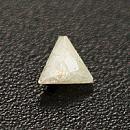|
|
||||||||||||||||
|
||||||||||||||||
|
||||||
|
|
|
|
Leadhillite
|
|
| | |
| Discovered in 1832; IMA status: Valid (pre-IMA; Grandfathered) | ||
|
| ||
|
Chemistry |
|
|
| |
|
Pb4(SO4)(SO3)2(OH)2 | |
|
|
Lead Sulfate Carbonate Hydroxide |
|
Molecular Weight: |
1,078.90 gm |
|
Composition: |
Hydrogen |
0.19 % |
H |
1.67 % |
H2O |
|
|
Lead |
78.82 % |
Pb |
88.68 % |
PbO2 |
|
|
Carbon |
2.23 % |
C |
8.16 % |
CO2 |
|
|
Sulfur |
2.97 % |
S |
7.42 % |
SO3 |
|
|
Oxygen |
17.80 % |
O |
|
|
|
|
|
100.00 % |
|
105.93 % |
= TOTAL OXIDE |
|
|
|
||||
|
Classification |
|
|
| |
|
Carbonates (Nitrates) | |
|
6/B.13-50 | |
|
|
5 : CARBONATES (NITRATES)
|
|
Related to: |
Trimorphous with: Macphersonite and Susannite. The monoclinic dimorph of Susannite. |
|
Varieties: |
None |
|
Synonyms: |
Lead sulphato-tricarbonate, Maxite, ICSD 64807, PDF 35-617 |
|
|
|
|
Crystal Data |
|
|
|
|
|
Crystals, to 13 cm, are usually thin to thick tabular pseudohexagonal, with hexagonal outline; several rhombohedral and pyramidal forms common; may be barrel-shaped, or pseudorhombohedral {101} and {142}, also prismatic parallel to [001], or equant, granular or massive. When [101] is developed the faces may show striations, or be curved. Over 40 forms noted; granular, massive. |
|
|
On {140}, {340}, {140}, very common, giving pseudohexagonal groupings. |
|
|
|
|
|
Physical Properties |
|
|
|
|
|
Perfect on {001} and easy. Parting: translation gliding on {001}, as well as twin gliding with K1(340), σ2[140]; K2(34¯0), σ1[140]. |
|
|
Irregular/Uneven |
|
|
Brittle |
|
|
2.5 - 3.0 |
|
|
6.55 (g/cm3) |
|
|
Pale yellowish under Short Wave UV |
|
|
Not Radioactive |
|
|
Thermal
Behaviour: |
Heating results in a reversible transformation into Susannite. 2E is approximately 20° (2V ~ 10°) at ambient temperature (for Na) and decreases with increasing temperature. It becomes uniaxial negative at about 125° and remains so at higher temperatures. |
|
Other: |
Soluble in nitric acid with effervescence, rendering a residue of lead sulphate. Exfoliates in hot water. |
|
Health Warning: |
Caution: Contains lead - always wash hands after handling. Avoid inhaling dust when handling or breaking. Never lick or ingest. |
|
|
|
|
Optical Properties |
|
|
|
|
|
Colorless, white, gray, pale yellow, yellow, yellowish green, pale green, pale bluish green, pale blue, brown; colorless in transmitted light |
|
|
Transparent to translucent |
|
|
Resinous to adamantine, pearly on {001} |
|
|
1.870 - 2.010 Biaxial ( - ) |
|
|
0.140 |
|
|
Strong; r < v |
|
|
n/a |
|
|
|
|
|
Occurances |
|
|
|
|
|
Geological Setting: |
An uncommon secondary mineral in the oxidation zone of lead deposits. |
|
Common Associations: |
Cerussite,
Anglesite, Lanarkite, Caledonite, Linarite (Leadhills,
Scotland); |
|
Common Impurities: |
n/a |
|
Type Locality: |
Susanna Mine (Glennery Scar Vein; Susanna Vein [Scar Vein]; Portobello Vein; Humby Vein; Lead Vein), Leadhills, South Lanarkshire, Strathclyde (Lanarkshire), Scotland, UK |
|
Year Discovered: |
1832 |
|
View mineral photos: | |
|
|
|
|
More Information |
|
|
|
|
|
| |
|
|
|
|
Distribution:
In Scotland, from Leadhills, Lanarkshire, and Wanlockhead,
Dumfriesshire; in the Drumruck mine, Kirkcudbrightshire.
In England, from Caldbeck Fells, Cumbria; at Penberthy
Croft, St. Hilary, and in the Greystone quarry, Levant,
Cornwall. From Bleiberg, Carinthia, Austria. In the
USA, from the Beer Cellar mine, Granby, Newton County,
Missouri; in the Tintic district, Juab County, Utah;
in Arizona, fine crystals from the Mammoth-St. Anthony
mine, Tiger, Pinal County, in the Rowley mine, near
Theba, Maricopa County, at the Grand Reef mine, Gila
County, and from Bisbee, Cochise County. In California,
at the Blue Bell claims, near Baker, San Bernardino
County; from the Searchlight district, Clark County,
and in the Chalk Mountain mine, Chalk Mountain district,
Churchill County, Nevada; from Leadville, Lake County,
Colorado. Very large crystals from Tsumeb, Namibia.
At Dundas, Tasmania, Australia. A few other localities
are known. |
|
|
We
have not photographed our Leadhillite
gems yet. Please
check back soon. |
